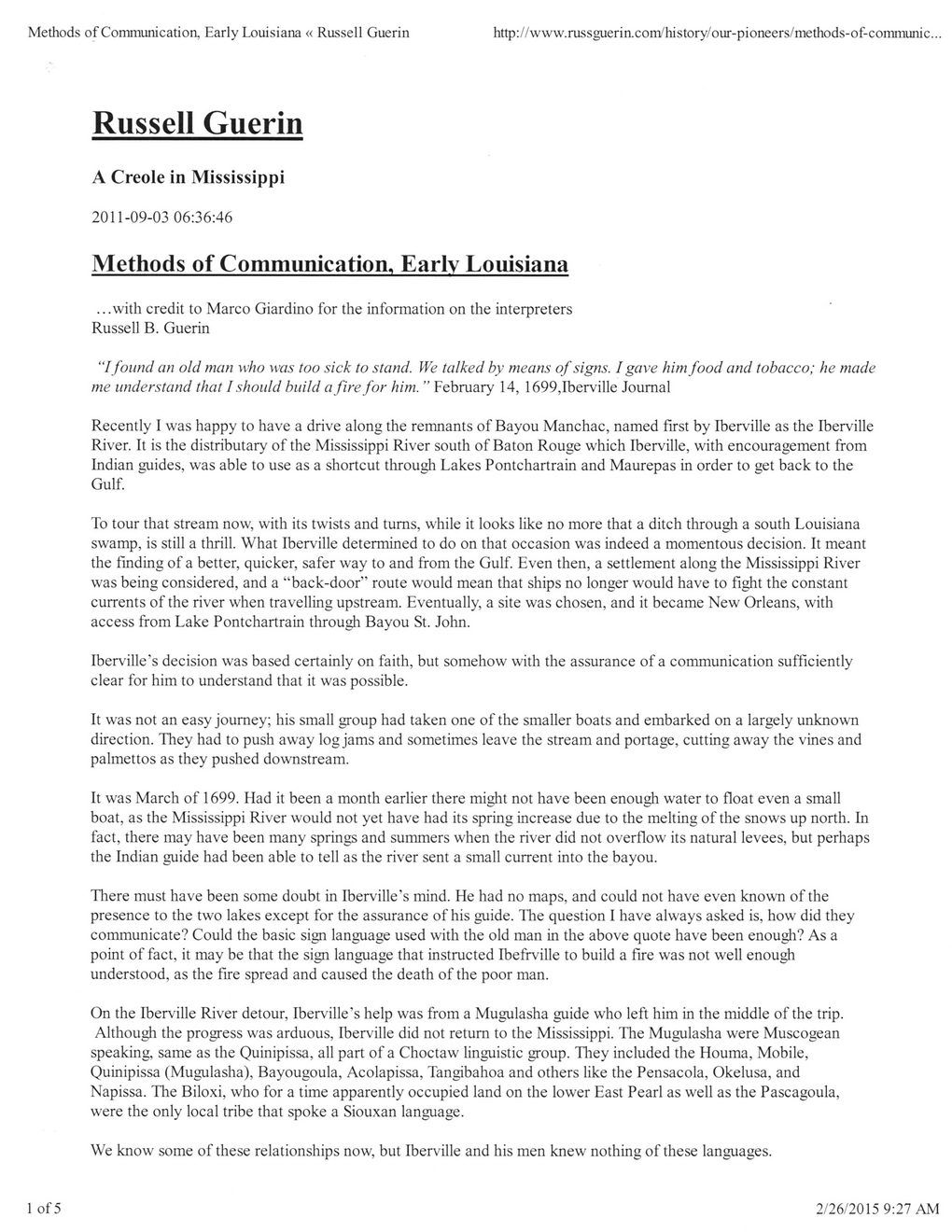This text was obtained via automated optical character recognition.
It has not been edited and may therefore contain several errors.
Methods of Communication, Early Louisiana « Russell Guerin http://www.russguerin.com/history/our-pioneers/methods-of-communic. Russell Guerin A Creole in Mississippi 2011-09-03 06:36:46 Methods of Communication, Early Louisiana .. .with credit to Marco Giardino for the information on the interpreters Russell B. Guerin “Ifound an old man who was too sick to stand. We talked by means of signs. I gave him food and tobacco; he made me understand that I should build a fire for him. ” February 14, 1699,Iberville Journal Recently I was happy to have a drive along the remnants of Bayou Manchac, named first by Iberville as the Iberville River. It is the distributary of the Mississippi River south of Baton Rouge which Iberville, with encouragement from Indian guides, was able to use as a shortcut through Lakes Pontchartrain and Maurepas in order to get back to the Gulf. To tour that stream now, with its twists and turns, while it looks like no more that a ditch through a south Louisiana swamp, is still a thrill. What Iberville determined to do on that occasion was indeed a momentous decision. It meant the finding of a better, quicker, safer way to and from the Gulf. Even then, a settlement along the Mississippi River was being considered, and a “back-door” route would mean that ships no longer would have to fight the constant currents of the river when travelling upstream. Eventually, a site was chosen, and it became New Orleans, with access from Lake Pontchartrain through Bayou St. John. Iberville's decision was based certainly on faith, but somehow with the assurance of a communication sufficiently clear for him to understand that it was possible. It was not an easy journey; his small group had taken one of the smaller boats and embarked on a largely unknown direction. They had to push away logjams and sometimes leave the stream and portage, cutting away the vines and palmettos as they pushed downstream. It was March of 1699. Had it been a month earlier there might not have been enough water to float even a small boat, as the Mississippi River would not yet have had its spring increase due to the melting of the snows up north. In fact, there may have been many springs and summers when the river did not overflow its natural levees, but perhaps the Indian guide had been able to tell as the river sent a small current into the bayou. There must have been some doubt in Iberville’s mind. He had no maps, and could not have even known of the presence to the two lakes except for the assurance of his guide. The question I have always asked is, how did they communicate? Could the basic sign language used with the old man in the above quote have been enough? As a point of fact, it may be that the sign language that instructed Ibefrville to build a fire was not well enough understood, as the fire spread and caused the death of the poor man. On the Iberville River detour, Iberville’s help was from a Mugulasha guide who left him in the middle of the trip. Although the progress was arduous, Iberville did not return to the Mississippi. The Mugulasha were Muscogean speaking, same as the Quinipissa, all part of a Choctaw linguistic group. They included the Houma, Mobile, Quinipissa (Mugulasha), Bayougoula, Acolapissa, Tangibahoa and others like the Pensacola, Okelusa, and Napissa. The Biloxi, who for a time apparently occupied land on the lower East Pearl as well as the Pascagoula, were the only local tribe that spoke a Siouxan language. We know some of these relationships now, but Iberville and his men knew nothing of these languages. 1 of 5 2/26/2015 9:27 AM

Explorers Methods-of-Communication-With-Native-Americans---Guerin-(01)